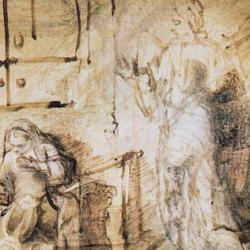Leviticus 1:7-9 describes the arrangement of animal parts for an ‘olah, an “ascension” offering. It’s a double or triple layering of the animal: head, suet, and entrails-and-legs; or, as a double structure with the entrails and legs set off from head and suet by the water barrier.
Mary Douglas (Leviticus as Literature) has suggested analogies between the animal-stack and the tabernacle and Mount Sinai. She thinks that the entrails and legs correspond with the Most Holy Place, but I think she has it backwards. The altar is the priestly ox/bull face of the cherubim, facing the tabernacle curtain and ultimately the ark, and his head goes first as he moves from the altar to the throne, where the Lion is.
The head is the highest place of the animal, and the MHP is considered the highest place in the tabernacle. The head thus corresponds to the high priest, who is is always the one who is surrounded by smoke and fire. (In the temple, the priest actually enters a wood environment in the sanctuary, with fiery gold on wall and floor.) The suet is, as Douglas suggests, a barrier between the upper and lower, and corresponds to the HP and to the priests. The bath is the clue: the laver is outside in the courtyard, and beyond the water you have the area for the lay Israelites, who correspond to the legs and entrails.
To tabernacle and Sinai analogies, we might add Edenic ones: The head of the animal is the “head” of the mountain in the land of Eden, the “suet” is the mediating garden, and, following out the water of the four rivers of Eden, you have the legs and entrails, the outer world. Or, we can say that head and fat are Adam and Eve, and that the entrails and legs are those who would “flow” from them.
One of the reasons Douglas thinks that the order is the reverse is the way the things are piled up on the altar. If you put the head in first, then the suet, then the entrails-and-legs, the latter are at the top of the stack. We can handle this apparently anomaly in a couple of ways. First, the animal goes head-first into the altar fire, in a kind of descent into the altar, but that descent leads to an ascent, as the animal is transformed into smoke and ascends as a pleasing aroma to Yahweh. Descent is the way of ascent.
Second, we might also say that Douglas’s point can stand as a subordinate dimension of the olah. In a sense, the animal does get turned inside out on the altar: the most intimate, most hidden parts of the animal are the most exposed. It’s a form of nakedness on the altar. That connects with the Edenic motifs that are here. The animal is a son of the Adam who is making the offering, and that son can draw near exposed in order to be clothed. Given the connotations of the inner organs (qereb), the things that are nearest, this is indicating that in a sense our inner being is our most holy place.
Yahweh claims every bit of us – head, suet, entrails and legs; our head, our breaks, our kidneys and our walk. But the entrails are the last course, the tasty dessert portions. Head is protological, first in being first; entrails and legs are eschatological, first in being last, most outer in being most inside.















